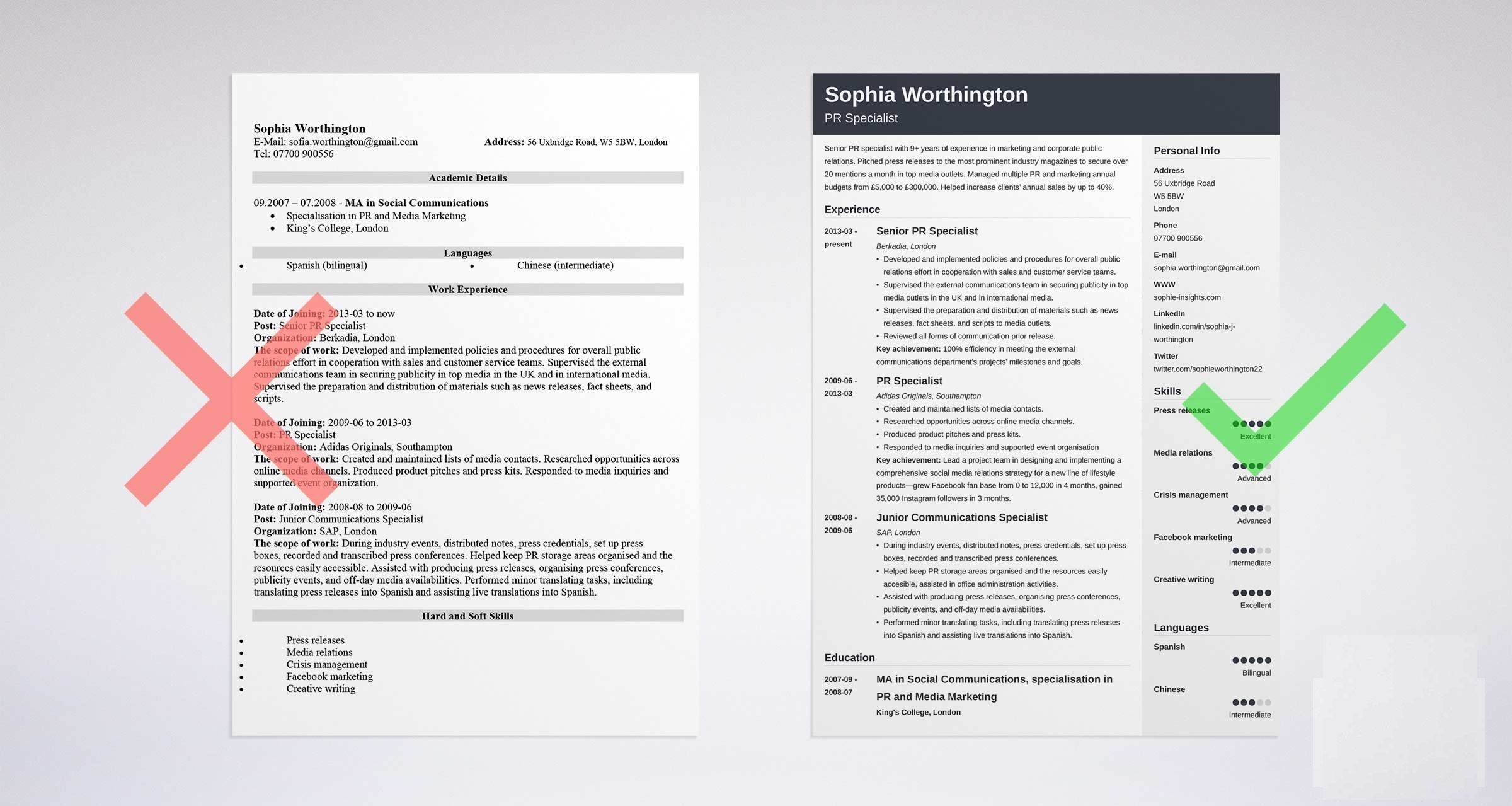
How to Write a Curriculum Vitae CV You’ve found the perfect job opportunity. You send your CV and you breathlessly wait for the call-back… but it never happens. Sound familiar? Yeah, it does for most of us. But how’s that possible?or a Job Application
How to Write a Curriculum Vitae CV for a Job Application
Want to find a job in the UK or USA It’s essential that you have a good CV that communicates to employers why you’re the best candidate for the position.
How to Make a Good CV
Writing a good CV is vital to finding a job. Follow our CV writing tips and you’ll have no trouble getting interviews in the industry you’re targeting — no matter your level of experience.
There are two ways to make a CV:
Use an online CV maker
Make a CV in Microsoft Word or Google Docs
Ready to get started? We clearly explain the best ways to make a CV and detail all the information you need to include. Let’s jump in:
Use a CV builder
The fastest way to make a CV is by using an online CV maker service.
CV makers are software developed to help people build a CV with minimal effort. An effective CV maker quickly guides you through the writing process and formats everything perfectly for you.
This type of software works by asking you a series of questions about your professional history, skills, and qualifications, and then provides you with suggested content to fill out your CV.
Write your CV with a Word Format
Particular about the way you want your CV to look or simply don’t want to deal with an online sign-up process? Making a CV yourself in Microsoft Word or Google Docs might be your best option.
How to write a CV from start to finish Writing a CV
yourself is straightforward. Here’s how to make a CV in eight steps:
Once you have an idea about what to include in your CV, it’s much easier to start writing it. Here’s how you should organise your CV sections:
1. Choose the ideal CV format for your professional background
Before you start writing your CV, you need to decide on an appropriate CV format.
If you have no major gaps in your employment or are still a student, you should use a reverse-chronological CV. This CV format’s defining feature is that it places your work experience section towards the top of the page, starting with your most recent work experience.
However, if you’ve had periods of unemployment or feel that the skills you’ve developed throughout your life are more impressive than your work experience, you should use a skills-based CV format.
The skills-based layout helps shift the focus of your CV from your employment history to the overall skills you have to offer.
2. List your name and contact details at the top
Now that you’ve decided on a format for your CV, it’s time to start filling out your information.

The heading of your CV sits at the top of the first page and includes your relevant personal information, including your:
- First and last name (don’t use ‘Curriculum Vitae’ as your title)
Target job title
Email address (use a professional email address like fred.bloggs@gmail.com)
Mobile phone number
Link to a professional profile or LinkedIn page
You no longer need to include your postal address on your CV because most companies will ring you if they want to schedule an interview.
Adding colour
A good CV title can include a splash of colour. For instance, this example draws the attention of recruiters with its green and grey background:

A CV can include a splash of colour and remain professional looking.
Don’t just pick your favourite colour though. Muted colours like dark green or blue are fine, but hot pink is too casual and risks making your application look unprofessional.
3. Open with a CV personal statement

An effective CV personal statement (also called a CV personal profile) summarises your key accomplishments, qualifications, and skills. It should be short: three to four sentences or bullet points is enough.
By adding a personal statement to the top of your CV, you make it easier for interviewers to decide if you’re worth asking in. They can quickly scan your personal statement before deciding whether to read the rest of your CV.
Additionally, use numbers in your personal statement to quantify your achievements. Numbers related to your previous occupations provide the employer with context, and show them what you can achieve for them.
Here’s an example accountant CV personal statement with numbers:
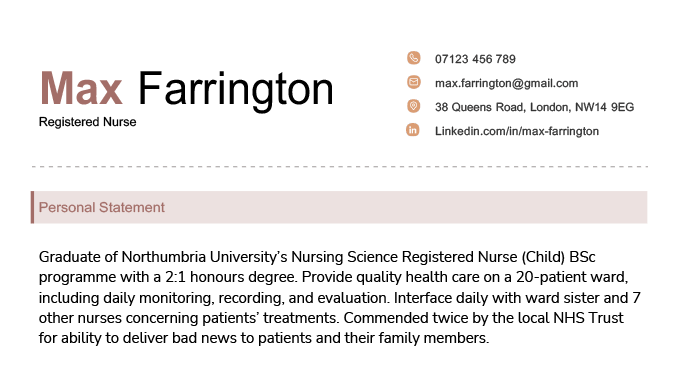
4. List your relevant work experience
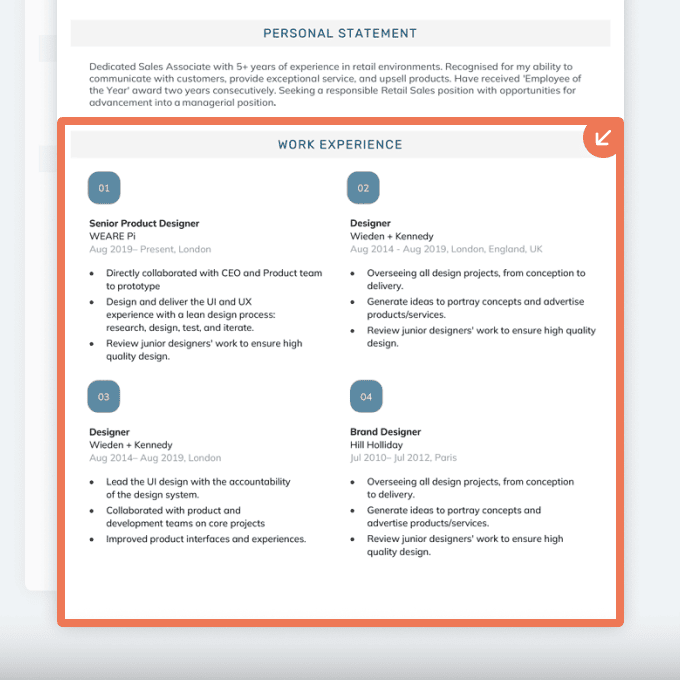
Whatever experience you have, list it in reverse chronological order. In other words, your most recent job goes first — then work backwards from there. Just like with your personal statement, use numbers as much as possible in your work experience section. If you don’t have exact numbers, make an educated guess — but don’t exaggerate. Your future employer might ring your former employer and ask about what you’ve said on your CV. For each entry, list your job title, the company’s name and location, and the dates you worked there.
5. Detail your educational
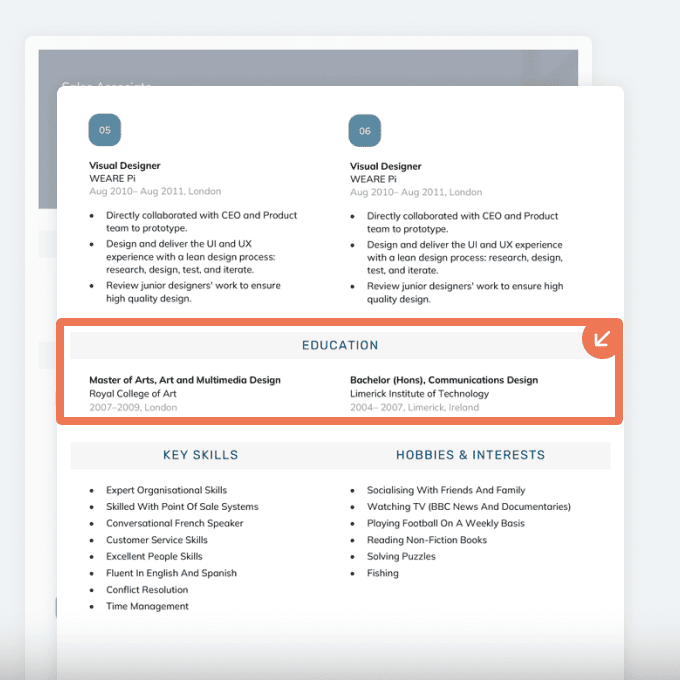
Your CV education section showcases all of your relevant academic qualifications. Along with your work experience, your educational background gives employers a sense of your specialities and professional interests.
In your education section, list your highest qualification first. Qualifications should generally be listed in this order:
- Doctorate
Master’s degree
Bachelor’s degree
A-Levels (or Highers/Advanced Highers in Scotland)
GCSEs (or N5 in Scotland) or vocational equivalents
You don’t need to list all of your GCSEs if you have a university degree or A-Levels. However, many employers require candidates to have at least Grades A–C (or Grades 9–4 under the 2017 reform) in English, Maths, and IT or other subjects, so you should mention these details. For example:
6. Include a list of your most marketable skills
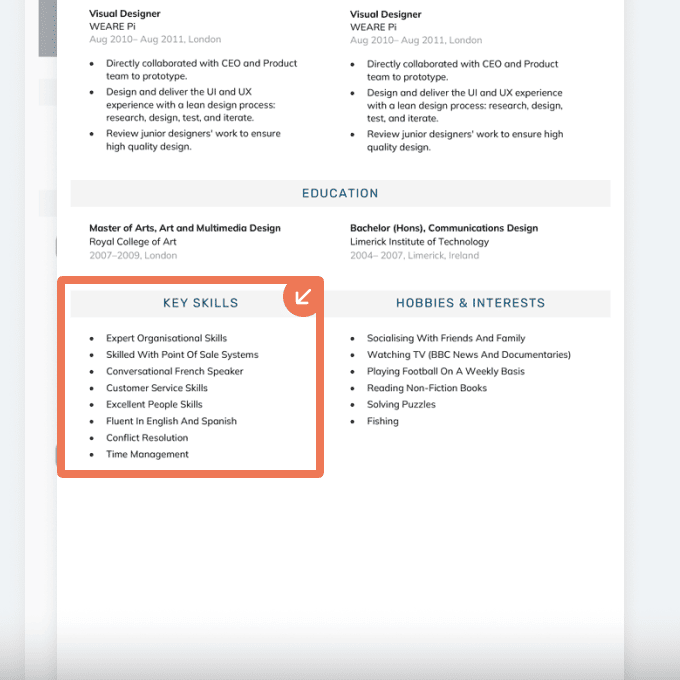
List your main professional skills on your CV in a dedicated section. Make sure you include technical skills as well as skills that show you work well as part of a team.
Technical skills
Technical skills are those you specifically learn. You might have a certification or licence to prove your level of expertise.
For example, if you’re applying to become a delivery driver, you need to state on your CV that you have a driving licence, like so:
You can also list skills you’ve gained from vocational qualifications on your CV. For example, if you have an NCFE CACHE Level 3 Award in Child Care and Education, you can list ‘Child Care’ among your skills. Other common technical skills include:
- Graphic design skills
Programming languages (for example, C++, Java, SQL, and Python)
Accounting tools (SAP, Oracle, and Intuit QuickBooks)
Data modelling (SQL Server Management Studio and MySQL Workbench)
Soft skills
You should also add some soft skills to your CV. Soft skills are skills related to your personality, and show that you’re good at working in teams. Here are some examples of soft skills employers are looking for in candidates:
- Customer service skills
People skills
Communication skills
Organisational skills
For each of your skills, include an example of when you used that skill in a workplace setting. Specifically, write out these examples in your work experience section to show employers how you’ve applied them in the past. For example:
7. Highlight other relevant information and hobbies
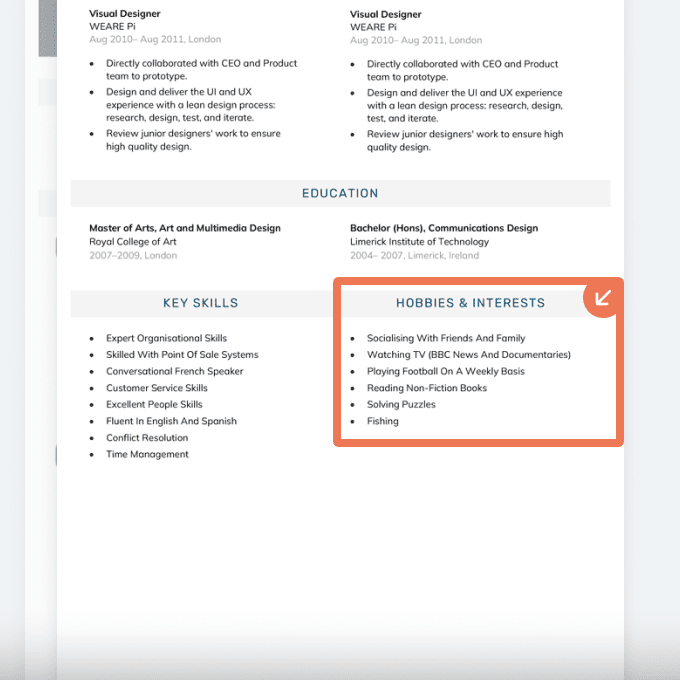
Employers appreciate some insight into who you are as a person. So if you have space at the bottom of your CV, you should add a hobbies and interests section. When outlining interests on your CV, try to only include hobbies that reflect well on your personality and show employers your positive attributes.
For example:
Being on your local football team shows you’re capable of teamwork
Duke of Edinburgh’s Award shows your independence, interpersonal skills, and problem solving abilities
Being a regular gym-goer shows your commitment to reaching personal goals
Playing a musical instrument shows dedication and creativity
You can also use your hobbies and interests section to add any extra skills or information that aren’t required for the job but still improve your job application. For example:
If you live in a rural area, showing you have a driving licence might reassure employers that you’d be able to make it into work without relying on public transport
If you’re applying to a job where you might interact with tourists, being able to speak other languages looks good on your CV even if language skills aren’t listed as a requirement
8. Properly lay out all of your information
It’s not only compelling content that’s important on your application, but also the CV layout you use. Follow these tips to format your CV properly:
CV colour
A splash of colour could give you an advantage by making your CV more visually appealing. However, be sure to stick to muted, professional colours like dark blue, burgundy, or dark green.
Alternatively, pastels are acceptable colours for a CV and communicate a softer, friendlier tone.
Graphics
Don’t use graphics on your CV, including infographics. Larger firms often use software called applicant tracking systems (ATS) that scan CVs for specific keywords to gauge whether you’re qualified for the job.
ATS software often can’t read graphics, so if you’ve painstakingly created a visual CV, it’s possible the ATS will struggle to read your job application.
To make sure your CV gets past an ATS, always use plain text.
CV font
Use a businesslike font for your CV to show that you take the job application process seriously. Any of these fonts are fine for a professional CV:
- Times New Roman
Georgia
Arial
Cambria
Calibri
Helvetica
Avoid casual or arty fonts like Comic Sans, Courier New, and Papyrus because they’re harder to read and make you come across as less professional to recruiters and employers.
Tips for writing your CV
If you’ve included each section we’ve outlined in this piece and filled it out with information relevant to the job you want, your CV should be almost ready to send out.
Here are a few last-minute CV tips to make your application even more persuasive:
Use action verbs to describe accomplishments
Many job seekers make the mistake of using the same generic phrases to describe their work duties:
- Responsible for
Tasked with
Entrusted with
By using these phrases, you’re naturally going to describe your duties rather than your accomplishments.
Describing your duties has the unfortunate consequence of making you seem like someone who simply takes orders, rather than someone who can solve problems and contribute at a higher level.
Check out this example of what not to do:
Bullet Point with Duty
- Responsible for answering phone calls from members of the public
This type of CV bullet point tells employers nothing about whether you were successful at your job. To solve this problem, use strong action verbs on your CV. Action verbs are compelling sentence starters because they make you seem like a proactive employee:
Bullet Point with Achievement
- Handled average of 47 inbound phone calls a day
Repeat keywords from the job advert
Applicant tracking systems (ATS), which scan CVs before passing them onto the recruiter, look for keywords on your CV. You can boost your chances of bypassing the ATS (and catching the attention of employers) by adding keywords from the job advert.
Pay close attention to the terms that the job advert uses in the requirements section. For example, here’s a real job advert with relevant keywords underlined:

The underlined terms are skills, experience, and qualifications that the company is looking for.
In this case, you should refer to your organisational skills, administrative skills, detail-oriented personality, and all the other skills mentioned here if you’re to impress this particular employer.
Add these words and phrases to your CV — whether in your personal statement, skills list, or work history — to make sure the ATS doesn’t block your job application.
Proofread your CV
One of the quickest ways to get your application rejected is by submitting a CV with typos or grammatical errors. Even if you’re not applying for a job where knowing how to write is important, having mistakes on your CV indicates to employers that you have poor attention to detail or are too lazy to check your work.
To avoid any potential mistakes, read your CV over again a couple of times before you send it out.
Reading your CV out loud really helps you notice any mistakes. Run your spell-checker on your CV, and check what it recommends.
Once you’re done checking and double-checking, give your CV to a friend, family member, or form tutor to look at. Often, a fresh pair of eyes will spot any problems you initially missed.
Choose an appropriate file format
You wouldn’t want to put together a professional CV only to be rejected because employers couldn’t open your file.
Once you’re happy with your CV, save it as either a DOCX or PDF. These two file formats are the most common file types to use for CVs. Because all companies have the right software to view these files, they’ll be able to read your CV properly.
Pair your CV with a compelling cover letter
You also need to write a cover letter, unless the job advert says not to include one.
While your CV lets recruiters and employers see your past successes, a cover letter links your accomplishments to the company you’re applying to. For example, if you’re applying to a pub that’s opening in your village, you can use a cover letter to directly tell the landlord you’ll help them train new bar staff.
While your CV just quickly touches upon such work experience, your cover letter makes you seem more like a person who can come in and do the work.
Sharing